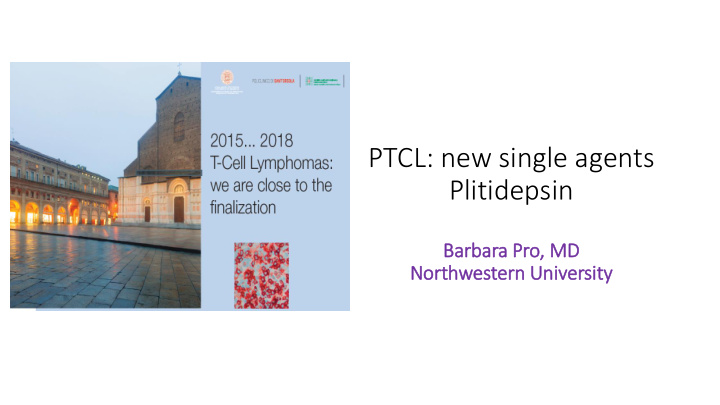



PTCL: new single agents Plitidepsin Ba Barbara Pro, , MD Nort rthwestern Univ iversit ity
Plitidepsin Demonstrated activity against several human malignant cell lines including leukemia and lymphoma
Pli litidepsin target Plitidepsin eEF1A • Proto-oncogene over-expressed in many tumor types • Aplidin resistant cells have low levels of expression of eEF1α • Re- introduction of eEF1α sensitizes the resistant cells to plilidepsin treatment 3 (Losada et al., AACR 2014; Abstract / Poster 5467; Role of the eukarytic elongation factor eEF1A in the mechanism of action of Plilidepsin) 3
Non-canonical fu functions of f eEF1 α Proto-oncogene over-expressed in many tumor types Reorganization of the actin cytoskeleton Favors cell migration and invasion Target mis-folded proteins to the proteasome Regulation of oxidative stress Inhibition of apoptosis 4
Pli litidepsin Currently over 1000 patients have been treated Activity: • Antitumor activity in phase I/II clinical trials in hematological diseases; Peripheral T-Cell Lymphoma and Multiple Myeloma Safety: • Myelosuppression is very uncommon and generally mild. • Main DLTs: myalgia, fatigue, CPK and transaminase elevations , transient and reversible Schedules: two short infusion schedules selected for further development: Weekly: RD = 3.2 mg/m 2 days 1, 8, 15 q4wk over 1-hr • 5
Plilidepsin-Phase II Study • Patients divided in two cohorts • Non-cutaneous PTCL • Other lymphomas • Dosing: plitidepsin 3.2 mg/m 2 (1-hour intravenous infusion) on days 1, 8, and 15 of a 28-day cycle • Patients with SD or response could continue to receive treatment until PD or unacceptable toxicity • Response assessed every 2 cycles Plilidepsin Plilidepsin Plilidepsin Plilidepsin 1 8 15 22 28 Ribrag V et al. Haematologica 2013;98:357-363
Plilidepsin-Phase II Study Efficacy Best response PTCL (n=34) Other (n=33) ORR 20.7 (29) - CR/Cru* 2 (5.9) - PR** 4 (11.4) 3 (11) SD 6 (17.6) 9 (33) NE 5(14.7) 3 (9.1) PD 17 (50) 24(72) *2 CR in AITL, both patients had failed ABMT ** 1 PR in AITL, 3PR in PTCL-NOS Ribrag V et al. Haematologica 2013;98:357-363
Plitidepsin-related adverse events (at least 5% of patients) Vincent Ribrag et al. Haematologica 2013;98:357-363
APL-B-021-13 PHASE II STUDY OF PLITIDEPSIN IN PATIENTS WITH RELAPSED OR REFRACTORY ANGIOIMMUNOBLASTIC T-CELL LYMPHOMA 10
Study desig ign • Primary obje jective: To evaluate the efficacy of plitidepsin on the basis of overall response rate (ORR) in patients with relapsing/refractory angioimmunoblastic T-cell lymphoma (AITL). • Sec econdary en endpoi oints: • Other secondary endpoints of efficacy: • Duration of response. • Progression-free survival, PFS at 6/12 months. • Intrapatient TTP/PFS. • Overall survival, OS at 6/12 months • Safety profile of plitidepsin in this patient population. • Pharmacokinetics (PK) of plitidepsin. • To identify biomarkers that may be clinical endpoint surrogates for future plitidepsin studies or that may be predictive of plitidepsin activity.
Statistical Methods • The primary endpoint for this study is ORR according to the Lugano classification 2014 response criteria per independent central review • Two futility analyses of the primary endpoint when approximately 25% and 50% of eligible patients have been treated (i.e., 15 and 30 patients, respectively). • For the first analysis ≥ 3 responders out of 15 patients are required. • For second analysis ≥ 8 out of 30 patients are required. • If these objectives are not met recruitment might be stopped at the time of the first or second futility analysis, respectively. • Otherwise, accrual will continue to a total of 60 patients. • If there are 19 or more responders over the total of 60 patients, the efficacy of plitidepsin will be considered as clinically relevant in AITL patients. • Active recruitment will not be halted while the analysis is being carried out.
Central Path thological Review-Biomarker Analysis • The pathologists responsible for the central pathological review will be responsible for: a) Confirming patient eligibility on the basis of investigative site pathology reports provided during screening, b) Analyzing tumor biopsies (initial diagnosis and/or relapses) to ensure consistency of the AITL diagnosis. c) Analyzing blood samples to identify plasma biomarkers. • The assessment of potential predictive factors • alterations in DNA and RNA, including DNA mutational status, RNA expression levels and miRNA expression, for common genetic lesions affecting the AITL clone • alteration in tumor tissue biomarkers including (but not limited to) assessment of pathways and mechanisms of action of plitidepsin, mainly status at the protein expression level; and • peripheral blood analyses, to identify plasma biomarkers including (but not limited to) cancer- related mutations and to extract DNA.
UPDATED STUDY STATUS 77008 10011 3 Screening Failure 09006 17 PATIENTS 14 patients 14 Patients 1 Non 14 Patients Not able to receive included Evaluable included included treatment 77008 13 Evaluable for general safety 13 13 Potentially 12 Evaluable for evaluable potentially response evaluable 1 Pending evaluation
Case • 59 years old woman with diagnosis of angioimmunoblastic lymphoma stage IVA refractory to 2 prior lines • She began treatment with plitidepsin 3 weekly doses every 4 weeks • After the first cycle she had resolution of laterocervical nodes • After 3 cycles a PET/CT showed that the original lesion resolved but there was an increase in FDG uptake without increasing in size of multiple other nodes
Original lesions Interim PET Previous to Plitidepsina The original lesion dissapeared but there is an increase in FDG uptake without increasing the size of multiple other nodes that were not hypermetabolic before therapy.
Conclusions • Plitidepsin has moderate single-agent activity with an acceptable safety profile in relapsed/refractory non-cutaneous PTCL patients. • Hematologic toxicity was not clinically relevant nor dose limiting in a heavily pretreated cohort, making plitidepsin an ideal agent to treat patients with limited bone marrow reserve and/or to combine it with other active drugs. • The ongoing clinical trial will hopefully elucidate the underlying molecular mechanisms responsible for the observed clinical selectivity in patients with AITL.
Recommend
More recommend